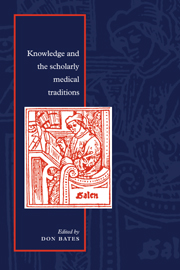17 - ALLAN YOUNG
Published online by Cambridge University Press: 01 February 2010
Summary
My work as an anthropologist has been divided between two medical traditions: traditional Ethiopian (Amhara) medical beliefs and practices and psychiatric medicine in North America. Ethiopian medicine includes a textual tradition, derived from Graeco-Arabic sources, but my knowledge of texts extends only to recipe books and divinatory texts – humble stuff compared to the traditions discussed at this workshop. On the other hand, while psychiatric medicine has a rich textual tradition, it is also rather far removed from the humoral traditions represented here. So I can claim no expertise in any of the scholarly discourses represented among the workshop's participants.
Because my own research has focused on clinical settings, I am disposed to see these textual traditions in a similar context. Throughout the workshop, I have been asking myself these two questions. What is or was the relation between these various texts and the medical practices that each encodes? What is or was the relation of the texts cum practices to sickness in these societies? I recognize that in many instances, we have only the texts and there is no plausible way to reconstruct the clinical realities. In my comments, I want to suggest that the questions are worth asking anyway, as a tentative step to contextualizing these literate traditions.
What I require at this point is a textual tradition to which I can claim equal access and expertise with the workshop's other participants. Fortunately for me, Dr Kuriyama has introduced just the thing. You may have missed it, since his (chance) remark flashed by before the start of his splendid paper on visual knowledge in classical Chinese medicine.
- Type
- Chapter
- Information
- Knowledge and the Scholarly Medical Traditions , pp. 355 - 360Publisher: Cambridge University PressPrint publication year: 1995
- 1
- Cited by

